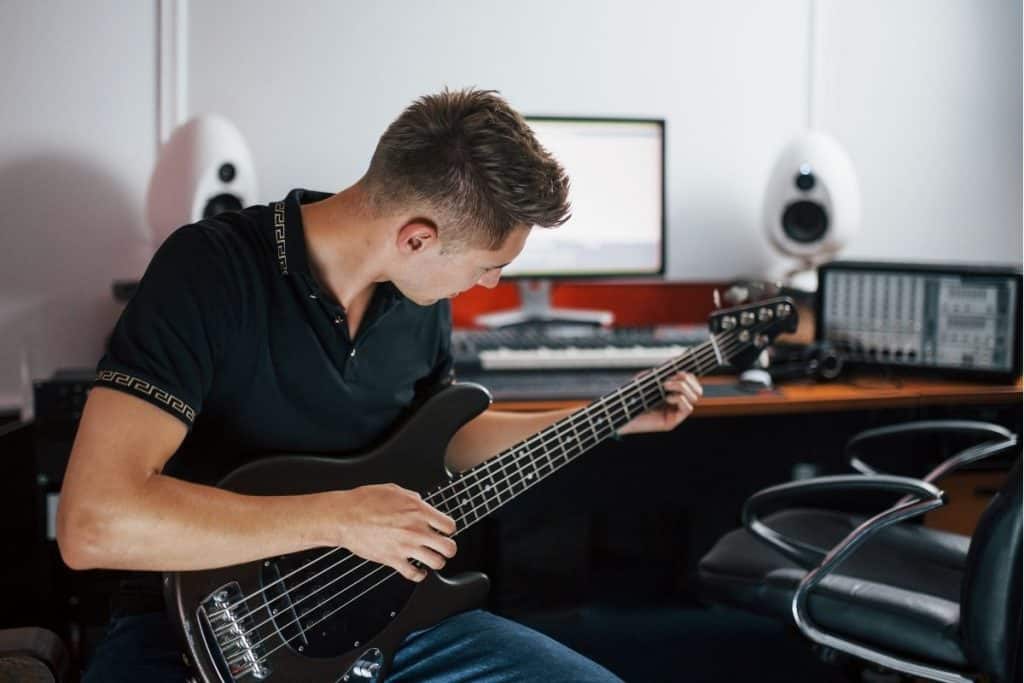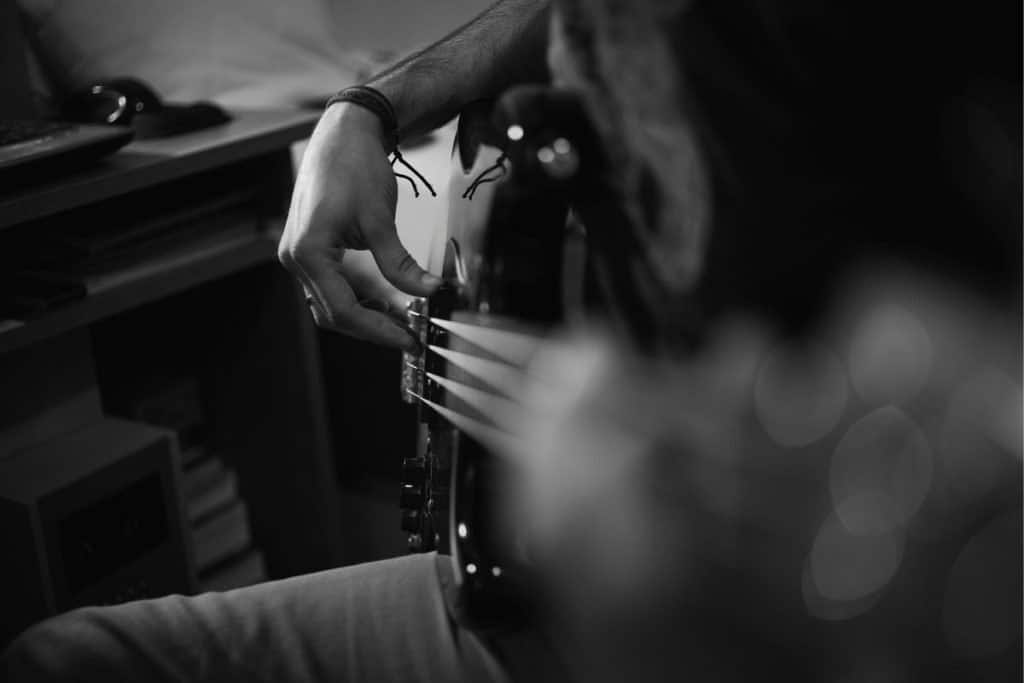So, your brand new bassline is sounding otherworldly and ready to unleash that slap-tastic tone on your new track.
However, if you’re new to recording, it’s easy to find yourself feeling tangled up and confused over which recording methods are best for you.

So, how exactly do you record a bass guitar, and what do you need to know before getting started? Stick with us to find out.
What Do You Need To Record A Bass Guitar?
If you’re sick of your lifeless-sounding bass tracks, you’ll be pleased to know that there’s more than one recording method to choose from. However, what you pick will depend on which equipment you have to hand.
To record your bass, you’ll need to get your hands on the following gear:
- An audio interface
- A computer
- Speakers or headphones
- Amp simulator or an amp
- ¼” cable
- DI Box (optional)
How To Record A Bass Guitar
As mentioned above, there are a few different ways you can record your bass guitar. We’ll walk you through some of the most common methods below.
Method One: Microphone And Amp
If you love to keep things simple, this is the method for you. For this method, you’ll need (you guessed it), nothing more than a microphone and an amp.
Here’s how to pull off the technique. Remember: the distance between your mic and the amp and the angle of your mic, will determine your tone, and how well your recording comes out.
We’d also recommend using a dynamic microphone – some are even made specifically for bass guitars!
The further you position your mic from the amp, the more pronounced your room and floor reflections will be.
This will give it a much more natural tone, so you’ll need to decide if this suits the style of music you’re recording.
Here’s a more in-depth look at the microphones you can use to record your bass with.
Dynamic Microphone
These microphones are the most common to record your bass on.
These microphones harness the power of a voice coil, a magnet and a diaphragm to detect and convert your sound waves into an electrical signal.
They can withstand high pressure levels, making them perfect for your bass recordings!
Ribbon Microphone
Ribbon microphones are considered the most natural mics to record an instrument or voice on. Ribbon mics use a thin, conductive, ribbon-like diaphragm to convert your sound waves into audio.
Their thin aluminum foil is incredibly sensitive and responsive, and will give your bass a crystal clear tone that’s unbeatable.
Method Two: Microphone And DI
This method will help you strike the perfect balance between thick tones and clear, 2D tones. Let us explain why. DI recorded basses, on their own, provide a crystal clear tone.
However, it can sound a little flat. However, recording through an amp gives a more saturated sound that’s thicker and punchier. Looking for the middle ground? Put the two together!

This will result in an unmissable bassline that’ll cut through the noise, and make a lasting impression on your listeners.
So, if you’ve got a groovy bassline that you really need to make a statement, blend the two together.
Method Three: MIDI Bass
What if you’re lacking equipment, working on a budget, or want to cut costs? In this case, we’d recommend the MIDI Bass. To pull this off, all you’ll need is an amp simulator and a bass VST.
If you’re not familiar with this technique, it may sound a little complicated. But fear not, it’s actually more straightforward than you might think!
Simply create a MIDI track, and add in your bassline. Record your bass directly through a MIDI keyboard, or just write the notes in yourself.
We’d recommend using an amp simulator with this method though.
Placing an amp simulator in your channel can make things sound more authentic, and emulate that classic studio tone you won’t get by recording directly with your MIDI keyboard.
One of the biggest perks of this technique is that everythings digital.
So, if you don’t like the sound or you make a mistake, you can easily change or delete parts without needing to re-record the whole thing! What’s not to love?
Don’t Forget The EQ
When you’re recording your bass, choosing when to cut or boost your EQ is one of the most important decisions you’ll have to make.
Finding the right EQ will determine how clean cut and controlled your final recording turns out.
To achieve the best results, we’d advise NO boosting your bass at the same frequency as your drum tracks.
This will help you keep that low end nice and tight, and avoid any ear-grating noises that you and your listeners WON’T appreciate.
Determining the right EQ will also dependon what kind of track you’re recording. For example, some bass tracks may benefit from a small, simple high-frequency boost.
Play around and find what feels right, but whatever you do, we’d recommend listening through a pair of headphones so you can really gauge your sound, and figure out the best way forward.
One final tip to remember: playing around with your EQ when your track is soloed is a recipe for disaster. To choose the right EQ, you need to be able to hear your track as a whole.
Listening to the ways your instruments all relate to each other will help you choose the best course of action, so please, DON’T play around with your EQ on a solo track!
The Bottom Line
Choosing the right recording technique can make or break your track. There’s nothing worse than pouring your heart and soul into a new bassline, only to mess it up your recording technique and mixing skills.
Before you commit to a recording method, do your research. Don’t forget to consider factors like your budget and recording space, too.
These will determine what gear you can and can’t mess around with. Figuring out what technology is at your disposal will make it clearer to choose the right recording technique for you.
